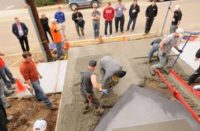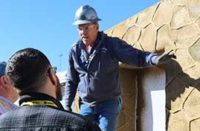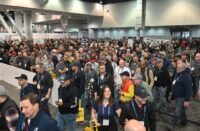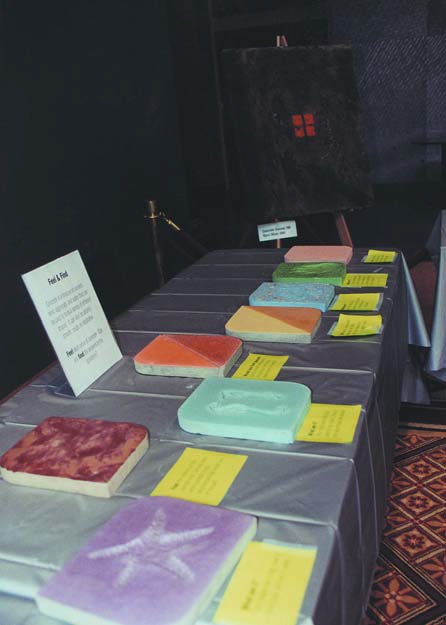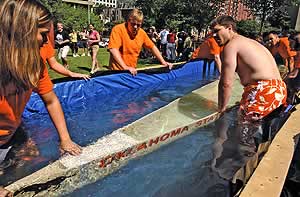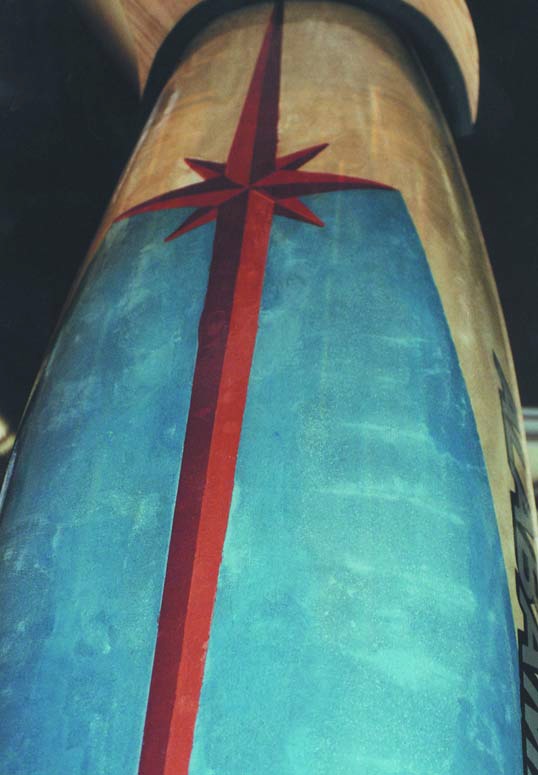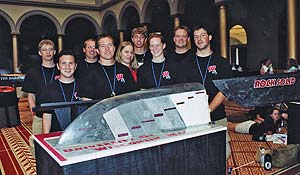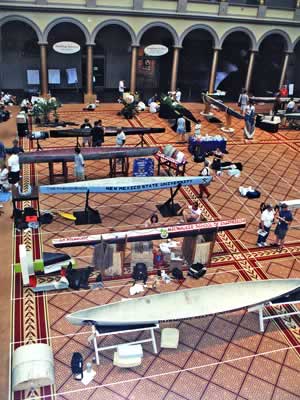 |
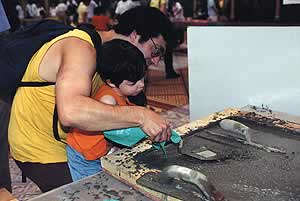 |
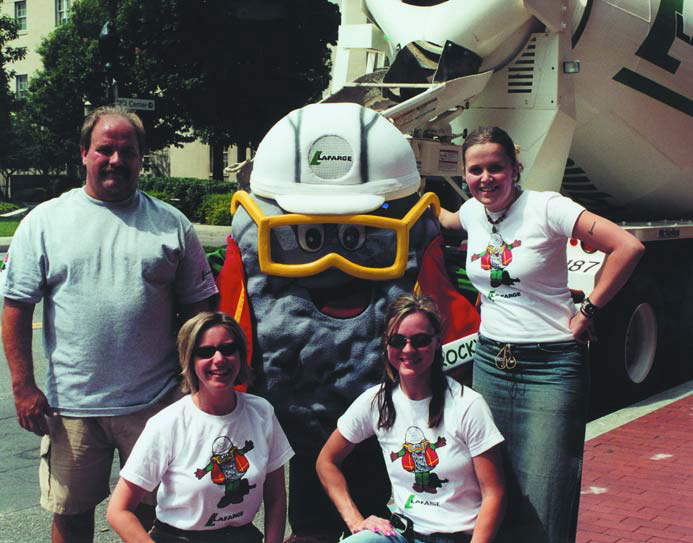 |
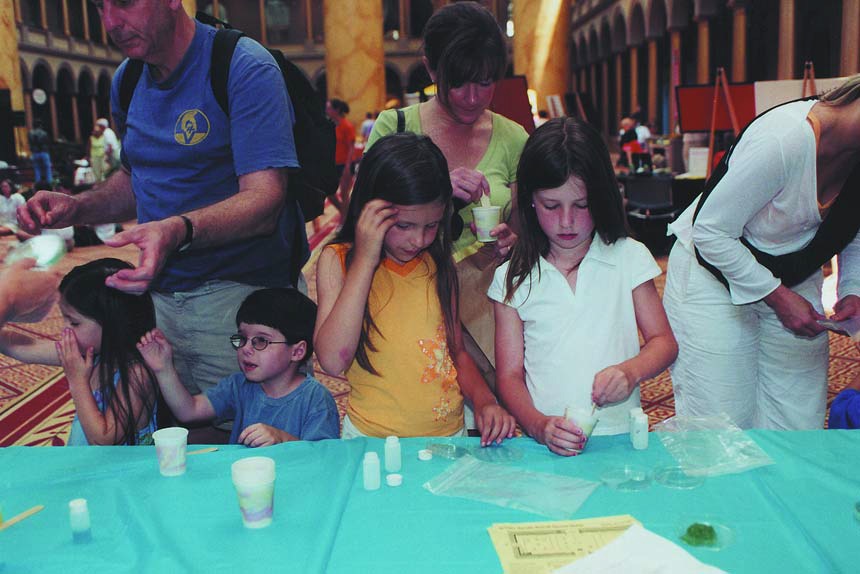 |
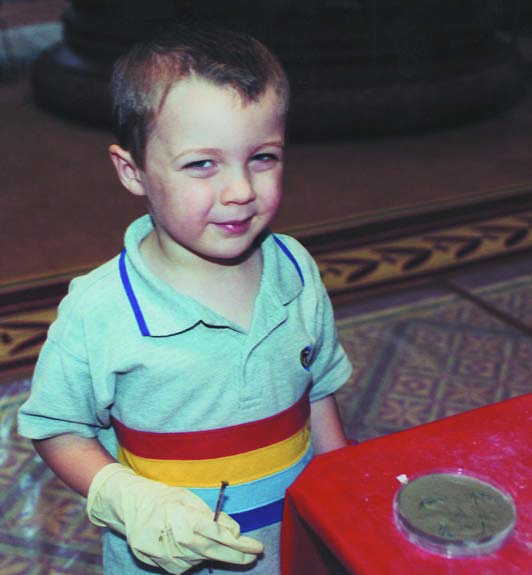 |
Concrete is both extraordinary and commonplace. Its chameleon-like attributes allow it to become so many things, from ordinary sidewalks and towering skyscrapers to patios that resemble slate and countertops that rival the finest stone. Both decorative and practical, concrete comes in any color imaginable, with a texture smooth, rough or in-between.
Contractors have appreciated these qualities for many years. And, thanks to a recent concrete extravaganza that featured a Concrete Carnival family festival, an exhibition and a concrete canoe competition, many not associated with the trade have learned to appreciate its surprising and fascinating properties, too.
The events, held in June, were primarily sponsored by the National Building Museum in Washington, D.C., and the American Society of Civil Engineers, Lafarge, and Degussa Admixtures Inc./Master Builders.
“Many people never give concrete a second thought — and fewer still understand how versatile and interesting it can be,” says Degussa Admixtures President and CEO Mike Shydlowski, whose company has sponsored the National Concrete Canoe Competition since 1988. This series of events in the nation’s capital was designed to change that line of thinking.
Fun for the whole family
To kick off the opening of the exhibition Liquid Stone: New Architecture in Concrete, the museum hosted a free Concrete Carnival, held June 19, that featured a variety of hands-on activities and demonstrations throughout the day. Participants had the opportunity to make and decorate a variety of concrete objects, mix themselves an “edible” concrete snack, see how concrete canoes float and explore many other remarkable aspects of concrete.
Lafarge’s mascot, Rocky, and a ready-mix truck greeted youngsters and parents as they arrived.
A Concrete Petting Zoo, sponsored in part by Concrete Decor, let visitors get up close and personal with a healthy sampling of various concrete species, including colorful specimens, plain-Jane varieties and even concrete blocks that float.
There was a concrete finishing booth for those who wanted to give the trowel a try. And for budding scientists and future contractors alike, several activity stations were designed to let people see firsthand that when certain substances are mixed together they cause a chemical reaction and create a new material.
“These simple experiments are designed to make people consider how extraordinary the ordinary can be,” says ASCE president Patricia D. Galloway, P.E. “When visitors walk outside after the festival, they’ll have a new appreciation for the substance below their feet.”
Concrete canoes in the capital
Festival-goers also had a chance to marvel at the ingenuity of scores of students from across North America who took part in the 17th annual ASCE/Master Builders National Concrete Canoe Competition. This year marked the first time in nearly a decade that the competition was held in the Washington, D.C., area.
The competition is designed to challenge students from top civil engineering
schools to make the improbable a reality: design, build and race canoes made of concrete. The overall scoring is equally based on four components: a written report, an oral presentation, the canoe itself and five different racing events, which were held at Lake Fairfax in Virginia.
Creating a canoe that can actually float is only half the battle. To be competitive, students also have to design a canoe with the right balance of characteristics for optimum speed, maneuverability, strength and stability.
In the process, they must follow certain rules, which change from year to year. This year, students were required to use a certain amount of ordinary sand as part of the aggregate mixture and either recycled coal fly ash or ground granulated blast furnace slag as the binding material. (Additional binding materials such as resins or polymers were also permitted.) No premixed or prepackaged concrete, mortar or grout mixtures can be used.
These new rules have caused teams to modify their “formulas for success” and have yielded heavier canoes, bucking the 15-year trend toward lighter, sleeker canoes. The average weight for canoes this year was 190 pounds. In 2003, it was 167 pounds and in 2001 it was a mere 117.
After nearly a year of preparation and an 800-mile journey to the nation’s capital, students from University of Wisconsin-Madison captured their second national title with their solid black, 180-pound, 21-foot 8-inch ‘Rock Solid’ canoe. It surpassed entries from 21 other schools not only in speed, but more importantly, in design, construction and overall performance.
Canada’s Université Laval paddled its way to second place with the Iceberg, a 117-pound grey-and-white racing machine. The University of Alabama in Huntsville came in third with the 148-pound white, blue, red and orange ConQuest.
“We have seen amazing technical advancements in the concrete canoe designs and construction over the past 17 years,” says Shydlowski. “Every year we challenge students to develop new ways to utilize concrete, and every year they produce boats that rival Olympic racing canoes in speed and maneuverability.”
The celebration continues
Although the festival and the canoe competition have come and gone, Liquid Stone: New Architecture in Concrete, the exhibit which features nearly 30 very recent or current projects that use concrete in exciting ways, remains on view through Jan. 23, 2005.
Additional sponsors for June’s events included Clark Construction LLC, Colormaker Floors Ltd., Concrete Decor magazine, National Ready Mixed Concrete Association, Quikrete, L.M. Scofield Co., Baker Concrete Construction, CEMEX USA and U.S. Silica Co.
